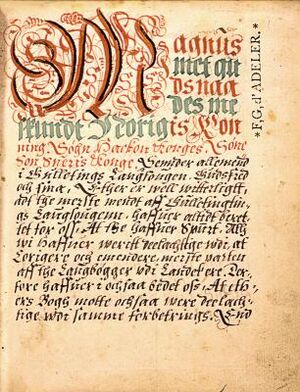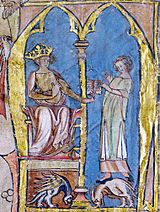Magnus VI facts for kids
Quick facts for kids Magnus the Law-mender |
|||||
|---|---|---|---|---|---|

Contemporary bust of Magnus VI from the Stavanger Cathedral, dated c. 1270s–80s.
|
|||||
| King of Norway | |||||
| Reign | 16 December 1263 – 9 May 1280 | ||||
| Coronation | 14 September 1261, Bergen | ||||
| Predecessor | Haakon IV | ||||
| Successor | Eric II | ||||
| Born | 1 May 1238 Tønsberg, Norway |
||||
| Died | 9 May 1280 (aged 42) Bergen, Norway |
||||
| Burial | Bergen Cathedral | ||||
| Spouse | |||||
| Issue | Eric II of Norway Haakon V of Norway |
||||
|
|||||
| House | Sverre | ||||
| Father | Haakon IV of Norway | ||||
| Mother | Margrete Skulesdatter | ||||
Magnus Haakonsson (born May 1, 1238 – died May 9, 1280) was the King of Norway from 1263 to 1280. He is best known as Magnus the Law-mender (Old Norse: Magnús lagabœtir) because he made big changes to Norway's laws. He was also the first Norwegian king to use a number after his name, calling himself "Magnus VI".
Contents
Early Life and Family
Magnus was the youngest son of King Håkon Håkonsson and his wife Margaret Skulesdatter. He was born in Tønsberg in May 1238. Magnus grew up mostly in Bergen.
In 1257, his older brother Håkon died. This made Magnus the next in line to become king. His father gave him the title of king that same year.
On September 11, 1261, Magnus married Ingeborg. She was the daughter of King Eric IV of Denmark. Magnus and Ingeborg were crowned right after their wedding.
On December 16, 1263, King Håkon died while fighting the Scottish king. Magnus then became the full ruler of Norway.
Magnus's Time as King
Changes in Foreign Policy
Magnus changed Norway's foreign policy from his father's more aggressive approach. In 1266, he gave up the Hebrides and the Isle of Man to Scotland. This was part of the Treaty of Perth. In return, Norway received a large sum of silver and yearly payments. This treaty also confirmed that Shetland and the Orkney Islands belonged to Norway.
In 1269, the Treaty of Winchester helped create good relations with the English King Henry III. Magnus also had good ties with the Swedish King Valdemar Birgersson. In the 1260s, the border with Sweden was officially set for the first time.
Important Internal Policies
Inside Norway, Magnus worked hard to update the country's laws. This is why he was called the "Law-mender." These new laws were approved at the Thing (a type of assembly) in 1274 and 1276.
In 1274, he introduced the new national law, called Magnus Lagabøtes landslov. This was a single set of laws for the whole country. It included the Faroe Islands and Shetland. This new law replaced the different regional laws that existed before.
Two years later, in 1276, he added a new law for cities, called Magnus Lagabøtes bylov. A slightly changed version was also made for Iceland. Having one set of laws for an entire country was very new at this time.
Magnus's law code said that a crime was against the state, not just against an individual. This helped reduce personal revenge. It also made the king's power stronger, as the king became the source of justice. The city law gave cities more freedom from rural control.
The royal succession was a very important issue. Civil wars over who would be king had only ended in 1240. In 1273, Magnus made it clear who would be his heir. He gave his five-year-old son, Eric, the title of king. His younger son, Håkon, was given the title of duke.
Magnus was a very religious king. However, his work on the laws caused some disagreements with the archbishop. The archbishop wanted the church to have more power over the kingdom. In 1277, King Magnus and Jon Raude, the Archbishop of Nidaros, signed an agreement called the Tønsberg Concord. This agreement confirmed some special rights for the clergy. It also gave the church freedom in choosing bishops. The church kept a lot of independence in legal matters. But it gave up its old claim that the Norwegian kingdom was under the Catholic Church's authority.
Magnus also continued his father's work of bringing European court culture to Norway. In 1277, he changed old Norse titles to European ones. He replaced lendmann and skutilsvein with baron and riddar (knight). These new titles came with extra rights and the ability to be called "lord."
Magnus was likely the first Norwegian king to use a number after his name. He called himself "Magnus IV" at first. After his father died, Magnus asked an Icelander named Sturla Þórðarson to write his father's story. In 1278, he asked the same person to write his own story. The Saga of Magnus the Law-mender was the last medieval Norwegian king's saga. Sadly, only a small part of it still exists today.
Death and What Happened Next
In the spring of 1280, Magnus became sick in Bergen. He had planned to crown his son Eric as co-ruler that summer. However, Magnus died on May 9, 1280. Eric became king at the age of 12. A group of advisors, including Magnus's widow Ingeborg, held the real power.
Magnus is remembered as a good ruler. He ruled by law instead of by fighting. He is often seen as a wise king. He avoided unnecessary wars and kept peace at home. He also brought Iceland under Norwegian control.
Magnus was buried in the church of the Franciscan monastery in Bergen. This church has been the Bergen Cathedral since the 16th century.
Other sources
|
Magnus VI
House of Sverre
Cadet branch of the Fairhair dynasty
Born: 1 May 1238 Died: 9 May 1280 |
||
| Regnal titles | ||
|---|---|---|
| Preceded by Haakon IV as sole king |
King of Norway 1257–1280 with Haakon IV (1257–1263) Eric II (1273–1280) |
Succeeded by Eric II as sole king |
See also
 In Spanish: Magnus VI de Noruega para niños
In Spanish: Magnus VI de Noruega para niños





